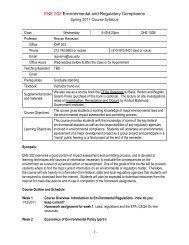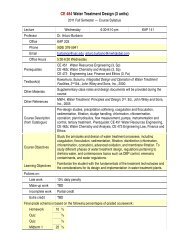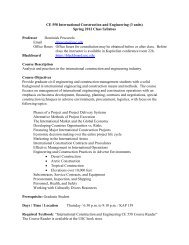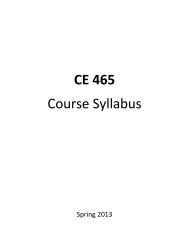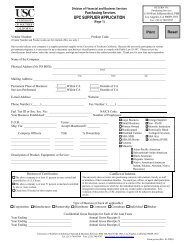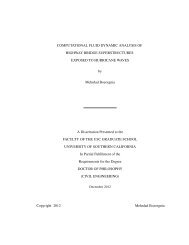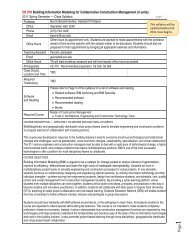Course Syllabus - Fall 2010 - USC - University of Southern California
Course Syllabus - Fall 2010 - USC - University of Southern California
Course Syllabus - Fall 2010 - USC - University of Southern California
You also want an ePaper? Increase the reach of your titles
YUMPU automatically turns print PDFs into web optimized ePapers that Google loves.
<strong>USC</strong><br />
UNIVERSITY<br />
OF SOUTHERN<br />
CALIFORNIA<br />
CE 210L<br />
Introduction to Environmental Engineering<br />
Microbiology<br />
Class Notes, Supplementary Reading Material,<br />
and Lab Handouts<br />
Instructor: Pr<strong>of</strong>essor Mike Pirbazari<br />
Department <strong>of</strong> Civil and Environmental Engineering<br />
<strong>University</strong> <strong>of</strong> <strong>Southern</strong> <strong>California</strong><br />
Spring <strong>2010</strong>
CE 210L Introduction To Environmental Engineering Microbiology<br />
Spring <strong>2010</strong> <strong>Syllabus</strong><br />
1<br />
Instructor: Pr<strong>of</strong>essor Mike Pirbazari (Dr. P)<br />
Office: KAP260; Phone: (213)740-0592, Fax:(213)744-1426<br />
E-mail: pirbazar@usc.edu<br />
Office Hours:<br />
Monday: 1:00 to 2:30pm<br />
Tuesday: 4:00 to 7:00pm<br />
Friday: 2:00 to 5:00pm<br />
Also, by appointment<br />
Class & Lab Hours: Lecture: Tuesday and Thursday 2:00-3:10pm; KAP 167<br />
Laboratory Sessions:<br />
Lab Coordinator:<br />
<strong>Course</strong> Content:<br />
<strong>Course</strong> Objective:<br />
Suggested<br />
Prerequisite:<br />
Session 1: Monday 11:00 to 12:50pm<br />
Session 2: Tuesday 11:00 to 12:50pm<br />
Session 3: Wednesday 11:00 to 12:50pm<br />
Erick Hernandez<br />
Office: BHE213K; Phone: (213) 740-6024<br />
E-mail: hernandez@usc.edu<br />
Principles <strong>of</strong> environmental microbiology; water-borne pathogens;<br />
microorganisms and air pollution; microorganisms in soil; water pollution<br />
microbiology; biodegradation <strong>of</strong> hazardous chemicals. The course will include<br />
the following design topics: i) design <strong>of</strong> a small biological wastewater<br />
treatment plant, and ii) biological treatment design for sanitary landfill<br />
leachate.<br />
The purpose <strong>of</strong> this introductory course is to provide the students the<br />
fundamental principles <strong>of</strong> microbiology for environmental engineering<br />
applications. The course includes laboratory work to <strong>of</strong>fer them a good<br />
experience in basic experimental techniques.<br />
CE 110 (Introduction to Environmental Engineering)<br />
Grading Criteria: 2 Midterm Exam 20% (10% each)<br />
Final Exam 15%<br />
2 Quizzes 10% (5% each)<br />
Homework 10%<br />
Lab Reports 25%<br />
Term Project 15%<br />
Class Participation 5%<br />
Schedules for Exams and Quizzes: 1 st Quiz September 14<br />
1 st Midterm October 5<br />
2 nd Quiz October 28<br />
2 nd Midterm November 10<br />
Final Dec. 9, 2:00-4:00 p.m.<br />
1
CE 210L Introduction To Environmental Engineering Microbiology<br />
Spring <strong>2010</strong> <strong>Syllabus</strong><br />
2<br />
Textbooks:<br />
Alcamo, I. Edward; Microbiology, Wiley Publishing, Inc. 1996<br />
Pirbazari, M; "Class Notes for CE210L, Introduction to Environmental Engineering<br />
Microbiology" with Supplementary Reading Materials ; adapted by Pr<strong>of</strong>. Pirbazari, <strong>2010</strong>.<br />
(Available on Blackboard)<br />
References:<br />
Willey, M.J.; Sherwood, L.M.; and Woolverton, C.J.; Prescot’s Microbiologv, Eighth Ed., W. C.<br />
McGraw Hill Publishing, 2011.<br />
Hammer, M. J., and Hammer Jr., M. J., Water and Wastewater Technology, 6 th edition, Prentice<br />
Hall, 2008.<br />
STATEMENT ON ACADEMIC INTEGRITY<br />
<strong>USC</strong> seeks to maintain an optimal learning environment. General principles <strong>of</strong> academic honesty include<br />
the concept <strong>of</strong> respect for the intellectual property <strong>of</strong> others, the expectation that individual work will be<br />
submitted unless otherwise allowed by an instructor, and the obligations both to protect one’s own<br />
academic work from misuse by others as well as to avoid using another’s work as one’s own.<br />
All students are expected to understand and abide by these principles. SCampus, the Student Guidebook,<br />
contains the Student Conduct Code in Section 11.00, while the recommended sanctions are located in<br />
Appendix A: http://www.usc.edu/dept/publications/SCAMPUS/gov/. Students will be referred to the<br />
Office <strong>of</strong> Student Judicial Affairs and Community Standards for further review, should there be any<br />
suspicion <strong>of</strong> academic dishonesty. The Review process can be found at: http://www.usc.edu/studentaffairs/SJACS/.<br />
STATEMENT FOR STUDENTS WITH DISABILITIES<br />
Any student requesting academic accommodations based on a disability is required to register with<br />
Disability Services and Programs (DSP) each semester. A letter <strong>of</strong> verification for approved<br />
accommodations can be obtained from DSP. Please be sure the letter is delivered to me (or to TA) as<br />
early in the semester as possible.<br />
DSP Contact Information<br />
Office location: STU 301<br />
Hours open:<br />
Phone number: (213) 740-0776<br />
8:30 a.m. until 5:00 p.m. — Monday through Friday.<br />
2
CE 210L Introduction To Environmental Engineering Microbiology<br />
Spring <strong>2010</strong> <strong>Syllabus</strong><br />
3<br />
<strong>Course</strong> Topics<br />
1. Ecological Principles ( 1 week)<br />
<br />
<br />
<br />
<br />
<br />
The Biosphere<br />
The Community<br />
Energy Transfer<br />
Homeostasis<br />
Ecosystem Management<br />
2. The Protists (1 week)<br />
<br />
<br />
<br />
<br />
<br />
<br />
Kingdoms in the Biological World<br />
Procaryotes and Eucaryotes<br />
Distribution <strong>of</strong> Microorganisms<br />
Culture Techniques<br />
Enumeration <strong>of</strong> Microorganisms<br />
Light Microscopy and Electron Microscopy<br />
3. Procaryotes and Viruses ( 1 week)<br />
<br />
<br />
<br />
<br />
Bacteria<br />
Actinomycetes<br />
Blue-Green Algae<br />
Viruses<br />
4. Eucaryotes (1 week)<br />
<br />
<br />
<br />
Fungi<br />
Protozoa<br />
Algae<br />
5. Microbial Nutrition and Growth (2 weeks)<br />
<br />
<br />
<br />
<br />
<br />
Nutrition<br />
Heterotrophy and Autotrophy<br />
Energy Transfer<br />
Microbial Growth Kinetics<br />
Growth Measurements<br />
3
CE 210L Introduction To Environmental Engineering Microbiology<br />
Spring <strong>2010</strong> <strong>Syllabus</strong><br />
4<br />
6. Death <strong>of</strong> Microorganisms (1 week)<br />
<br />
<br />
<br />
Physical Destruction (temperature, sonication , uv irradiation, osmotic shock, etc.)<br />
Chlorination Process and Chick’s Law<br />
Heavy metals, Iodine, Ozone, and Permanganat as Disinfectants<br />
7. Waterborne Pathogens (1 week)<br />
<br />
<br />
<br />
<br />
<br />
<br />
Bacteria<br />
Viruses<br />
Protozoa<br />
Schistosomiasis<br />
Detection <strong>of</strong> Fecal Contamination<br />
Detection <strong>of</strong> Viruses<br />
8. Sanitary Sewer Pipe Design (1 week)<br />
<br />
Gravity Flow in Circular Pipes<br />
• Manning Formula and Manning Nomograph<br />
• Gravity Flow in Partially-Full Sewer Pipes<br />
9. Conventional and Advanced Wastewater Treatment (1 week)<br />
<br />
<br />
<br />
Biochemical Oxygen Demand (BOD) and Suspended Solids<br />
Activated Sludge Process<br />
Biological Treatment for Nitrate Removal<br />
10. Municipal Wastewater Treatment Design (2 weeks)<br />
<br />
<br />
<br />
<br />
<br />
<br />
<br />
Role <strong>of</strong> Microorganisms in the Activated Sludge Process<br />
BOD, Suspended Solids, and Discharge Standards<br />
Flow Diagram and Schematics<br />
Determining the size <strong>of</strong> the Grit Chamber<br />
Determining the size and shape <strong>of</strong> the Primary and Secondary Clarifiers<br />
Determining the Size <strong>of</strong> the Aeration Tank and Air Flow Requirements<br />
Chlorination Tank Design<br />
4
CE 210L Introduction To Environmental Engineering Microbiology<br />
Spring <strong>2010</strong> <strong>Syllabus</strong><br />
5<br />
11. Biological Treatment Design for Landfill Leachate ( 2 weeks)<br />
<br />
<br />
<br />
<br />
Leachate Characteristics and Discharge Guidelines<br />
Leachate Collection System: piping layout, pumps, and holding tanks<br />
Leachate Equalization Tank<br />
Biological Aeration Tank ( bacteria and powder activated carbon suspension)<br />
• * Reactor size and carbon usage<br />
• * Clarifier size and sludge re-circulation<br />
12. Environmental Engineering Biotechnology (1 week)<br />
<br />
<br />
<br />
<br />
In-Situ and Ex-Situ Bioremediation <strong>of</strong> Contaminated Soil and Groundwater<br />
Vapor-Phase Bi<strong>of</strong>iltration for Treatment <strong>of</strong> Industrial Emissions<br />
Biodegradation/Adsorption Technology for Decontamination <strong>of</strong> Petroleum Hydrocarbons<br />
Phytoremediation Technology for Decontamination <strong>of</strong> Environmental Pollutants<br />
5
CE 210L Introduction To Environmental Engineering Microbiology<br />
Spring <strong>2010</strong> <strong>Syllabus</strong><br />
6<br />
Term Project<br />
Each student will be required to present a term project, which will constitute 15% <strong>of</strong> the semester grade.<br />
A list <strong>of</strong> suggested topics is provided below. Students are required to submit a choice <strong>of</strong> topic by<br />
September 16 th , <strong>2010</strong>.<br />
A 20-minute Powerpoint presentation on the term project topic is mandatory. Student presentations will<br />
be made in class on Nov. 30 th and Dec. 2nd and , <strong>2010</strong>. A sign up sheet will be passed around in class<br />
Nov. 23 rd , <strong>2010</strong>.<br />
Suggested Topics<br />
<br />
<br />
<br />
<br />
<br />
<br />
<br />
<br />
<br />
<br />
<br />
<br />
<br />
<br />
<br />
Bi<strong>of</strong>iltration Processes for Treating Industrial Gas Emissions<br />
Microorganisms and Energy Production<br />
In Situ and Ex Situ Bioremediation <strong>of</strong> Petroleum Hydrocarbons in Soil<br />
Bioventing and Bioremediation <strong>of</strong> Volatile Organic Compounds (VOCs) in Soil<br />
Biological Treatment <strong>of</strong> Leachate from Landfills<br />
Bioremediation <strong>of</strong> Petroleum Hydrocarbons in Marine Environment<br />
Ex-Situ Bioremediation <strong>of</strong> Volatile Organic Compounds (VOCs) in Groundwater<br />
Microbial Ecology <strong>of</strong> Activated Sludge Process<br />
Microbiologically-Induced Corrosion (MIC)<br />
Biological Treatment <strong>of</strong> Toxic Metals<br />
Microbial Ecology <strong>of</strong> Anaerobic Digestion Tank<br />
Role <strong>of</strong> Enzymes in Environmental Engineering Biotechnology<br />
Microbial Fuel Cell<br />
Phytoremediation <strong>of</strong> Soil and Groundwater<br />
In Situ Bioremediation <strong>of</strong> Groundwater<br />
6
CE 210L Introduction To Environmental Engineering Microbiology<br />
Spring <strong>2010</strong> <strong>Syllabus</strong><br />
7<br />
Laboratory Schedule<br />
Session # Week <strong>of</strong>: Experiment # Experimental Work<br />
1 Aug. 30 1<br />
I. Laboratory Safety Overview<br />
II. Introduction to the Compound Microscope<br />
2 Sept. 6 2 The Plankton Community<br />
3 Sept. 13 3 The Bacteria<br />
4 Sept. 20 4 Water Quality Testing: The Coliform Test<br />
5 Sept. 27 5 Water Quality Testing: Membrane Filtration<br />
6 Oct. 4 1 st Midterm<br />
7 Oct. 11 6 Activated Sludge and Hanging Drop<br />
8 Oct. 18 Field Trip<br />
9 Oct. 25 7<br />
Enrichment Culture and Selective Techniques for Isolating<br />
Anaerobic Bacteria from Environment<br />
11 Nov. 1 8 Soil Microorganisms and Chemostat Studies<br />
12 Nov. 8 2 nd Midterm<br />
13 Nov. 15 9 Electron Microscopy<br />
14 Nov. 22 10 Microorganisms and Energy Production<br />
15<br />
Nov. 30,<br />
and Dec. 2<br />
Paper Presentations<br />
16 Dec. 9 Final Exam — 2:00 to 4:00pm<br />
7
CE 210L Introduction To Environmental Engineering Microbiology<br />
Spring <strong>2010</strong> <strong>Syllabus</strong><br />
8<br />
Laboratory Report Instructions<br />
1. Your laboratory data reports should be taken/presented in 8" x 11" sheets stapled at the left-hand<br />
upper corner.<br />
2. All data and experimental write-ups should be word-processed.<br />
3. Laboratory reports will be collected at the beginning <strong>of</strong> the lab session for the experiment conducted<br />
on the previous session.<br />
4. No late report will be accepted.<br />
5. In your laboratory write-up, you must conform to the following format:<br />
The first page <strong>of</strong> your laboratory report should contain:<br />
CE 210L<br />
INTRODUCTION TO ENVIRONMENTAL ENGINEERING MICROBIOLOGY<br />
LABORATORY REPORT<br />
EXPERIMENT #<br />
Experiment title<br />
GROUP #<br />
YOUR NAME<br />
DATE<br />
Starting from the second page, the write-up must include the following sections:<br />
PURPOSE:<br />
DATA:<br />
RESULTS & DISCUSSIONS:<br />
SUMMARY:<br />
QUESTIONS AND ANSWERS:<br />
8
CE 210L Introduction To Environmental Engineering Microbiology<br />
Spring <strong>2010</strong> <strong>Syllabus</strong><br />
9<br />
Effective Class Participation<br />
Please note the following suggestions for effective class participation:<br />
1. Make every effort to interact with your class partner(s).<br />
2. Try to stay active throughout the class period.<br />
3. Don’t hesitate to ask questions in class.<br />
4. Share your ideas with the rest <strong>of</strong> us.<br />
5. Don’t hesitate to ask the instructor to repeat himself.<br />
6. Keep an eye on your partner not to fall asleep in class!!<br />
7. Try to bring new ideas to class.<br />
8. Don’t read unrelated materials in class.<br />
9. Share your ideas for class improvement with your instructor.<br />
10. Put your fair share <strong>of</strong> efforts in preparing the term projects and the term paper. Be cooperative<br />
at all times.<br />
11. Discuss your term paper and term project with the instructor periodically.<br />
12. Come to class prepared.<br />
13. Help your instructor make the class interesting.<br />
14. Discuss your concerns and problems (if any) about the course with the instructor. He will do his<br />
best to accommodate your suggestions.<br />
15. Late homework is not accepted.<br />
16. Use <strong>of</strong> Lap tops in class is not permitted.<br />
17. Tardiness is not acceptable.<br />
9


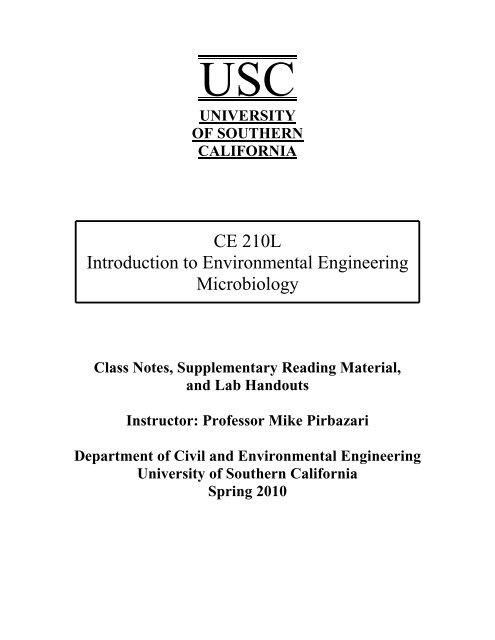

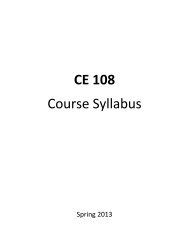
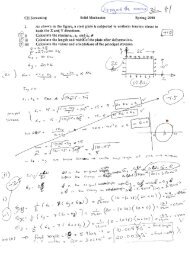
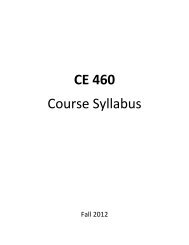
![Dr. Yan Xiao Bamboo Road Bridge can Support 16-Ton[ne] - USC](https://img.yumpu.com/37910641/1/190x245/dr-yan-xiao-bamboo-road-bridge-can-support-16-tonne-usc.jpg?quality=85)
